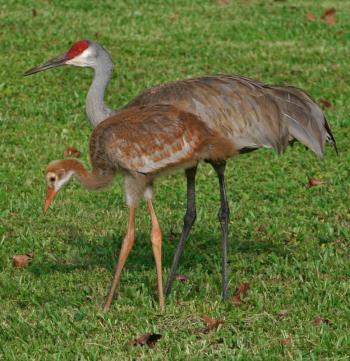Maine has Nesting Cranes?
Sandhill cranes are imposing birds, one of Maine’s largest, as we wrote about here a few years back. We remember the first ones we ever saw in the state back in the 1980s. One was a bird that stalked around Scarborough Marsh, typically pretty far away and distorted by heat waves. Sometimes it looked like a blurry image of a person walking with an odd, lurching gait. One of the most striking memories of our early Maine crane sightings happened one evening on the Kennebunk Plains when we were startled by a loud, prehistoric-sounding, trumpeting “kuk-err, kuk-err” rattle call from behind us. After the initial scare that almost jumped us out of our boots, we realized it was a migrant sandhill crane coming in for a landing. Perhaps it was calling with the hope that it would find other sandhill cranes in the expansive blueberry barren grasslands there.
Sandhill cranes continued to be rare spring and fall migrant visitors to the state in the decade or so after we saw our first ones in Maine. But in 2000, the late ornithologist Scott Melvin (who was mentored in his early years by many of the same elderly women birders in the Bangor area that fostered Jeff’s early bird interests), confirmed that a pair had successfully nested in the extensive marshes at the southern end of Messalonskee Lake in Belgrade.
There have been sandhill cranes there virtually every year since then. In fact, this location is one of the most popular among Maine birders to find the species. We saw a pair there this past June as we enjoyed views of the black terns that nest there and in only a few other spots in the state.
Now nearing 20 years since the first confirmed nesting, there are probably at least 10 or 12 breeding pairs in the state, ranging from Fryeburg in the west to Corinna and Plymouth in the east. It is rather amazing how the birds can keep such a low profile during the breeding season. Along with the ones in Belgrade, we have also seen birds at Smithfield and on Torsey Pond in Kents Hill. We have heard about birds being in Leeds for years but have never located those particular ones ourselves.
Sandhill cranes typically lay two eggs per year and take two to three years to reach breeding age. Of course, not all nests are successful and juveniles may not make it through the perils of their migration to and from the southern U.S. wintering grounds. This means that sandhill crane populations grow rather slowly.
Clearly our Maine population has shown continued growth over the last two decades, and this is part of a larger pattern of the spread of sandhill cranes across New England and New York. We haven’t found any direct explanation for the increase in the range and numbers of the species in the Northeast. Could it be related to higher overwinter survival in the southern U.S. because of a warmer climate? We don’t know, but we will keep an eye out for any studies that provide insight into the reasons why Maine is now blessed with nesting sandhill cranes.
Jeffrey V. Wells, Ph.D., is a Fellow of the Cornell Lab of Ornithology. Dr. Wells is one of the nation's leading bird experts and conservation biologists, and is author of the “Birder’s Conservation Handbook.” His grandfather, the late John Chase, was a columnist for the Boothbay Register for many years. Allison Childs Wells, formerly of the Cornell Lab of Ornithology, is a senior director at the Natural Resources Council of Maine, a nonprofit membership organization working statewide to protect the nature of Maine. Both are widely published natural history writers and are the authors of the popular books, “Maine’s Favorite Birds” (Tilbury House) and “Birds of Aruba, Bonaire, and Curaçao: A Site and Field Guide,” (Cornell University Press).




























